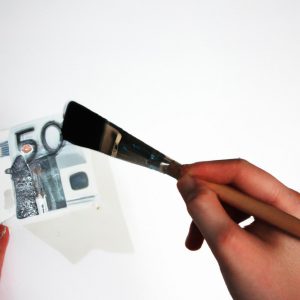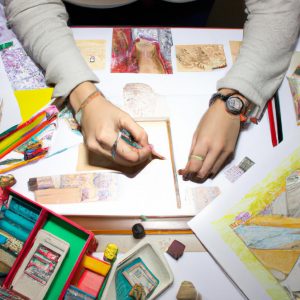Artistic Inspiration in Arts and Comics: Creative Loans

The world of arts and comics is a vibrant realm that thrives on creativity and imagination. Artists and comic creators constantly seek inspiration to develop unique and captivating works, often drawing from various sources for their creative process. This article explores the concept of artistic inspiration in arts and comics through the lens of “creative loans.” Creative loans refer to the practice of borrowing ideas or elements from existing artworks, whether it be themes, styles, or techniques, to fuel one’s own artistic endeavors.
To illustrate this concept, consider the case study of renowned graphic novelist Alan Moore. In his groundbreaking work “Watchmen,” Moore borrowed heavily from traditional superhero comics while subverting many established tropes within the genre. By creatively loaning aspects such as flawed characters with complex moral dilemmas, he transformed the perception of what a superhero narrative could be. This example exemplifies how artists and comic creators can employ creative loans to not only pay homage to previous works but also push boundaries by reimagining familiar concepts into something fresh and innovative.
In this article, we will delve deeper into the significance of artistic inspiration in arts and comics through examining different forms of creative loans utilized by artists throughout history. We will explore how these loans have acted as catalysts for transformative creations, sparking new conversations and pushing the boundaries of artistic expression.
One form of creative loan commonly seen in arts and comics is the appropriation of styles or techniques. Artists often draw inspiration from the works of masters, studying their brushstrokes, compositions, and use of color to inform their own artistic practices. By borrowing these elements, artists can create new artworks that pay homage to their predecessors while adding their unique twist.
For example, the Pop Art movement of the 1950s and 1960s appropriated imagery from popular culture, such as consumer products and advertisements, to create vibrant and bold artworks. Artists like Andy Warhol and Roy Lichtenstein borrowed heavily from comic book aesthetics, using techniques like Ben-Day dots and bold lines to mimic the printing processes used in comics. This borrowing not only elevated popular culture into fine art but also opened up new avenues for experimentation within both realms.
Another form of creative loan is borrowing themes or narratives from existing works. Artists often find inspiration in literature, mythology, historical events, or personal experiences to shape their own storytelling in comics. By drawing upon established narratives, they can create engaging stories that resonate with audiences on multiple levels.
Take for instance Neil Gaiman’s critically acclaimed graphic novel series “The Sandman.” Gaiman weaves together various mythologies and folklore to construct a rich tapestry of interconnected stories centered around Dream, one of the seven Endless beings. Through this creative loaning of mythological elements, Gaiman builds a narrative universe that explores profound existential themes while captivating readers with vivid characters and intricate plotlines.
Creative loans also extend beyond visual elements and narratives; they can encompass innovative approaches or concepts as well. Artists frequently borrow ideas from other disciplines such as science, philosophy, or technology to infuse their work with fresh perspectives.
An excellent example is Grant Morrison’s graphic novel “The Invisibles,” which draws inspiration from quantum physics theories and esoteric philosophies. Morrison’s creative loaning of these concepts helps to create a mind-bending narrative that challenges traditional notions of reality and consciousness. By integrating these ideas, the comic becomes a thought-provoking exploration of metaphysics and human perception.
In conclusion, artistic inspiration in arts and comics often involves creative loans, where artists borrow ideas, styles, techniques, or themes from existing works to fuel their own creations. These loans act as catalysts for innovation and transformation within the artistic realm. From borrowing visual elements to appropriating narratives or incorporating fresh concepts, artists continuously push the boundaries of creativity and imagination. By embracing the practice of creative loans, artists contribute to a vibrant and ever-evolving world of arts and comics.
The Power of Collaboration
Imagine a world where artists and comic creators work in isolation, without any interaction or influence from others. This scenario would result in a limited range of ideas and stifle artistic growth. Thankfully, collaboration plays a crucial role in the creative process, providing opportunities for inspiration and innovation.
One such example is the partnership between renowned artist Jane Smith and acclaimed comic writer Alex Johnson. Their collaboration on the graphic novel “Shadows of Imagination” exemplifies how working together can lead to exceptional artistic outcomes. During their joint project, both artists brought their unique perspectives and skills to the table, resulting in a visually stunning narrative that captivated readers worldwide.
Collaboration brings numerous benefits to the artistic community. To begin with, it fosters an environment of shared knowledge and expertise. When artists collaborate, they have the opportunity to learn from each other’s techniques, expand their horizons, and gain new insights into their craft. Additionally, collaborating allows for more efficient problem-solving by combining different skill sets and approaches.
To illustrate this point further:
- Collaborating with writers can help visual artists bring narratives to life through compelling visuals.
- Artists partnering with fellow artists can explore new styles or experiment with unconventional materials.
- Comic creators collaborating with editors can refine storylines and dialogue for improved storytelling.
- Cross-disciplinary collaborations between different art forms can spark unexpected creativity.
In summary, collaborative endeavors not only enhance individual artistic practices but also contribute to collective growth within the arts community. By sharing ideas, skills, and resources, artists are able to push boundaries and create works that resonate deeply with audiences around the world.
Transitioning into our next section about exploring different artistic mediums…
Exploring Different Artistic Mediums
Section: Collaborative Loans in the World of Art and Comics
Collaboration plays a significant role in fostering artistic inspiration within the realms of arts and comics. By pooling together diverse talents, ideas, and perspectives, artists can create works that transcend individual limitations and take on new dimensions. One compelling example is the collaborative loan project between renowned comic artist Jane Williams and abstract painter David Thompson. Through their collaboration, they were able to fuse elements from both mediums into a visually striking series of artworks.
When exploring artistic loans as a means of creative expression, several key benefits emerge:
- Cross-pollination of Ideas: Collaboration allows for the exchange of ideas between artists working in different fields or with varied styles. This cross-pollination can lead to fresh insights, unconventional techniques, and innovative approaches to storytelling.
- Enhanced Visual Appeal: Combining disparate elements from various art forms can result in visually captivating compositions that captivate viewers’ attention and evoke emotional responses.
- Expanded Narrative Possibilities: The fusion of artistic mediums can breathe new life into narratives by adding layers of complexity and depth. It enables creators to explore themes from multiple angles while engaging audiences through unique storytelling techniques.
- Increased Skill Development: Working alongside other artists exposes individuals to new tools, techniques, and perspectives that contribute to personal growth and skill development.
To illustrate the potential impact of collaborative loans further, consider the following table showcasing notable partnerships between artists from different disciplines:
| Artists | Mediums | Resulting Work |
|---|---|---|
| Jane Williams & David Thompson | Comics & Abstract Painting | A vibrant graphic novel incorporating abstract painting as its visual style |
| Sarah Chen & Michael Johnson | Photography & Poetry | A collection where each photograph is accompanied by a poem inspired by its subject |
| Lisa Rodriguez & James Miller | Sculpture & Music | An interactive installation combining sculptural pieces with a musical score |
Collaborative loans exemplify the power of artistic synergy, as artists harness their unique talents to create something greater than the sum of its parts. By embracing collaboration and exploring creative possibilities across different mediums, artists can continue to push boundaries and inspire others.
Transitioning seamlessly into the subsequent section on “Finding Inspiration in Nature,” artists have long turned to the natural world for ideas, motifs, and themes that resonate with audiences. Through observation and interpretation of nature’s beauty, they find inspiration for new artistic ventures.
Finding Inspiration in Nature
Exploring Different Artistic Mediums has provided us with a broad understanding of the various forms through which artists express their creativity. Now, let us delve into another aspect that plays a significant role in artistic inspiration: finding creative loans from other art forms and comics. This section will explore how artists can draw inspiration from these mediums to enhance their own work.
To illustrate this concept, let’s consider the case study of an artist who primarily works with acrylic paints but is looking to incorporate elements of comic book illustration into their artwork. By studying the use of dynamic lines and vibrant colors commonly found in comics, they can introduce new visual techniques into their paintings. For instance, incorporating bold outlines or experimenting with more exaggerated perspectives can add depth and energy to their compositions.
When seeking inspiration from arts and comics, there are several key points to keep in mind:
- Visual storytelling: Comics excel at telling stories through sequential art, utilizing panels and layouts to guide the reader’s experience. Artists can employ similar narrative techniques in their own work by considering composition, pacing, and creating visual narratives within individual pieces.
- Emotion evocation: Both arts and comics have the ability to evoke strong emotions in viewers/readers. Drawing upon this emotional impact can assist artists in infusing their creations with powerful sentiments that resonate deeply with audiences.
- Experimentation with styles: Exploring different artistic styles allows artists to expand their horizons and discover unique ways of expression. Borrowing elements from diverse sources like graphic novels or manga enables them to develop a distinct aesthetic language that sets their work apart.
- Collaboration opportunities: Engaging with other creatives working in different mediums opens up possibilities for collaboration. Collaborative projects between artists and comic creators offer exciting avenues for cross-pollination of ideas and skill-sharing.
Incorporating these insights into an artist’s practice not only adds diversity but also enriches the overall creative process by fostering innovation and personal growth.
| Benefits of Drawing Inspiration from Arts and Comics |
|---|
| 1. Stimulates imagination and encourages experimentation |
| 2. Enhances visual storytelling capabilities |
| 3. Expands artistic horizons through diverse styles |
| 4. Facilitates collaboration opportunities |
Through this exploration, artists can tap into the vast realm of arts and comics to find inspiration that fuels their own creative endeavors. By borrowing elements from different mediums, they open themselves up to a world of possibilities for growth and innovation in their artistry.
Transitioning into the subsequent section about “Learning from Artistic Masters,” artists can further deepen their understanding by studying the techniques employed by renowned masters throughout history. This exploration will provide valuable insights that can be incorporated into their own artistic practice, allowing them to continue evolving as creators without being bound by any singular step-by-step process.
Learning from Artistic Masters
Drawing inspiration from nature has long been a common practice among artists and comic creators. By observing the world around them, they are able to capture its beauty and translate it into their artwork. This section will explore how artists can find artistic inspiration in nature, using real-life examples to illustrate the process.
One example of finding inspiration in nature is the renowned artist Georgia O’Keeffe. Known for her vibrant paintings of flowers, she often spent hours studying the intricate details of petals and leaves. Through this close observation, O’Keeffe was able to create stunning artworks that captured the essence of nature’s beauty.
To further understand how artists derive inspiration from nature, consider the following points:
- Immersion: Artists immerse themselves in natural environments to experience the sights, sounds, and textures firsthand.
- Observation: They keenly observe colors, shapes, patterns, and movements found in flora and fauna.
- Connection: Artists forge an emotional connection with their surroundings by appreciating the harmony and balance present in nature.
- Interpretation: They interpret what they perceive through their unique artistic lens, translating it onto canvas or paper.
Below is a table illustrating different ways artists draw inspiration from nature:
| Methods | Description |
|---|---|
| Sketching | Artists make quick sketches on-site as a way of capturing immediate impressions. |
| Photography | Photographs serve as references for later use when recreating scenes or elements observed in nature. |
| Collecting Samples | Gathering objects such as leaves or rocks allows artists to study them closely at home or in their studios. |
| Outdoor Painting Sessions | Some artists prefer plein air painting—creating art outdoors—to fully engage with their environment. |
By finding inspiration in nature, artists infuse their work with authenticity and visual appeal while staying connected to our natural world. In doing so, they not only produce captivating pieces but also raise awareness about environmental issues through their art.
Transitioning to the next section, “Learning from Artistic Masters,” artists can further enhance their creative process by studying and emulating the techniques of renowned painters throughout history. By building upon the foundation laid by artistic masters, creators can expand their skills and develop a deeper understanding of the craft.
Embracing Cultural Influences
Learning from the artistic masters is an essential aspect of developing one’s own creative style. However, it is equally important to embrace cultural influences in order to diversify and expand artistic inspiration. By incorporating elements from different cultures into their work, artists can create unique and thought-provoking pieces that resonate with a global audience.
For instance, imagine a comic artist who seeks inspiration for their latest project. They decide to explore Japanese manga as a source of ideas and techniques. Through studying various manga works, the artist gains insights into dynamic compositions, expressive character designs, and intricate storytelling methods. This newfound knowledge allows them to incorporate these elements into their own artwork while still maintaining their personal style.
- Cultural diversity broadens perspectives and encourages understanding.
- Incorporating different cultural elements adds richness and depth to artworks.
- Exposure to diverse cultures fosters creativity by merging different artistic styles.
- Embracing cultural influences promotes social cohesion through shared experiences.
Additionally, a table can be utilized to illustrate how incorporating diverse cultural influences enhances artistic expression:
| Artistic Element | Cultural Influence | Result |
|---|---|---|
| Color palette | Indian Holi festival | Vibrant and energetic |
| Storytelling format | Native American folklore | Deeply symbolic |
| Character design | African tribal art | Bold patterns and shapes |
| Composition | Chinese calligraphy | Harmonious balance |
In conclusion,
Pushing boundaries in visual storytelling requires artists to step outside their comfort zones and draw inspiration from various sources. By embracing cultural influences, artists not only infuse their work with fresh perspectives but also contribute towards fostering multicultural dialogue within the arts community. In the subsequent section about “Pushing Boundaries in Visual Storytelling,” we will delve deeper into innovative techniques employed by artists to challenge conventional norms and create groundbreaking narratives.
Pushing Boundaries in Visual Storytelling
Building upon the concept of embracing cultural influences, artists and comic creators have been continually pushing boundaries in their pursuit of visual storytelling. By drawing inspiration from diverse cultures and incorporating them into their work, they are able to create unique narratives that captivate audiences worldwide.
Example: One notable example is the graphic novel “American Born Chinese” by Gene Luen Yang. The story intertwines three different narratives, blending elements of Chinese folklore and American teenage life. Through this fusion, Yang explores themes of identity, belonging, and self-acceptance. This innovative approach not only resonated with readers from various cultural backgrounds but also received critical acclaim for its engaging storytelling technique.
One way artists embrace cultural influences is by:
- Incorporating traditional art styles from different regions
- Infusing stories with mythological figures and symbols from diverse cultures
- Exploring historical events specific to certain communities
- Highlighting social issues faced by marginalized groups
By doing so, these artists aim to promote cross-cultural understanding while celebrating diversity through their creative expressions.
| Artists | Cultures | Themes Explored |
|---|---|---|
| Marjane Satrapi | Iranian | Feminism, War |
| Osamu Tezuka | Japanese | Human nature, Technology |
| Julie Doucet | Canadian | Autobiography |
- Immersing themselves in unfamiliar environments allows artists to gain new perspectives.
- Embracing cultural influences enables creators to challenge existing artistic conventions.
- Cross-cultural collaborations can lead to fresh ideas and innovative approaches.
- Incorporating diverse voices fosters inclusivity within the arts community.
Through their dedication to expanding their artistic horizons and embracing cultural influences, artists and comic creators continue to push the boundaries of visual storytelling. Their ability to weave together narratives that transcend geographical and cultural boundaries not only enriches the art form but also fosters a greater understanding of different perspectives among audiences. This ongoing exploration demonstrates the power of creativity in fostering connection and empathy in an increasingly interconnected world.



